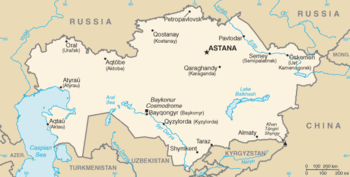Kazakh wine

Kazakh wine is
History

The earliest evidence of viticulture in Kazakhstan appear during the 7th century AD around
In general the emphasis will be on inexpensive table wine, although the UN thinks that the
Climate and geography
As an inland country, Kazakhstan has a very typical continental climate. Most of the region's vineyards are located in the southern half of the country near the borders of China, Uzbekistan, and Kyrgyzstan with a few smaller regions along the Caspian Sea in the west. Average annual rainfall varies throughout the country ranging from 4-6 inches (100–150 mm) in the wine regions around Atyrau and Aktobe to 27-39 inches (700–1000 mm) in the regions around the Talas River.[1]
Grape varieties
Currently the Kazakhstan winemaking has largely focused on
Classification
At present there is no appellation system in Kazakhstan.
Wine regions
About 80% of the country's wines are produced at the Issyk Winery Archived 2019-12-25 at the Wayback Machine in Issyk, some 40 kilometres (25 mi) east of Almaty. Bought by the Swiss-based Consulting Group in 1996 and recently sold back to local company Dostar, it has gone under considerable changes with the help of Italian-based winery Marcato Vini and an Australian consultant. Major reconstruction has been undertaken, with the importation of "New World" technologies including sweeping arm fermenters, air bag presses, cross flow filtration and nitrogen production. It benefits from being 850 m up in the Tian Shan mountains of the southeast of the country.[2] Other wineries include Bakhus and the Turgen Winery. There are 210 hectares of vineyards in the Zailiyskiy region of the Almaty Oblast. In Soviet times there were vineyards and wineries in the Sarkand and Alakol regions of Dzhungar Alatau, in the Almaty Oblast, but these were hit hard by the breakup of the Soviet Union.[3]
See also
References
- ^ ISBN 0-19-860990-6
- ^ a b c "Kazakh wines seek place in the sun". Reuters. 1998-03-31. Archived from the original on 2007-09-30. Retrieved 2007-06-21.
- ^ a b United Nations Development Programme; Government of the Republic of Kazakhstan (2005-02-23). "In situ Conservation of Kazakhstan's Mountain Agro-biodiversity" (PDF). Global Environment Facility. Archived from the original (PDF) on 2007-06-09. Retrieved 2007-06-21.
